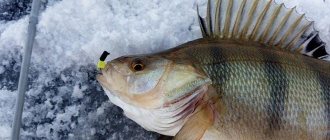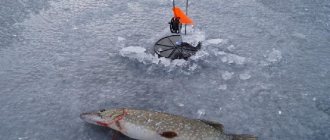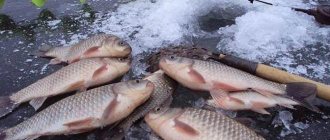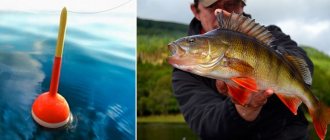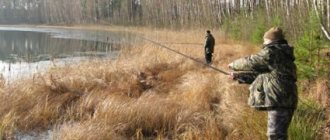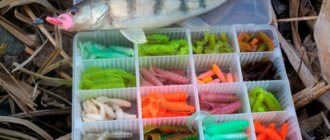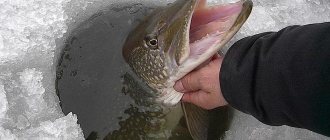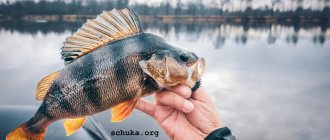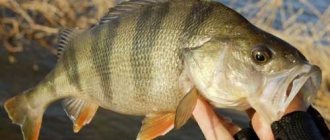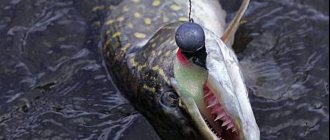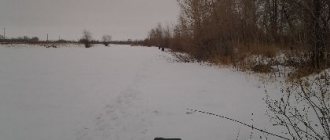On some reservoirs, catching perch on the first ice sometimes turns into getting fish out of a hole. However, such gluttony is not a constant phenomenon. It’s good if you can find a cauldron of a fattening predator. But more often the perch bite on the first ice is still less energetic, and sometimes even passive.
You need to look for fish, select bait and playing technique. It is easier to catch perch on the first ice than in other periods of winter. But this does not mean that you do not need to use the correct tactics and fishing techniques.
Behavior of perch in the first ice
Fishing for perch on the first ice is interesting and, with the right approach, rewarding. Even in stagnant city reservoirs, where there are no other fish except small sailors and roach, at the beginning of winter you can have a blast. In normal reservoirs there is even more of this predator, and, moreover, it is large enough for gastronomic purposes.
Many anglers who miss winter fishing are waiting for the first ice to catch some perch. This is an excellent period for beginners to enter the world of winter fishing, and for experienced ones to again feel close contact with fish after a summer break.
- Catching perch on the first ice is easy. But catching a lot and constantly is more difficult. To do this, you need to systematize your own efforts and purposefully search for a predator, using the right tactics and equipment. The striped fish's bite greatly depends on local conditions.
- In some reservoirs, in the same year as the ice begins to form, there is a strong zhor. On others or in other years there is a lull with stabilization only after a few days.
- Usually, perch is active just after the first ice and in the next 2-3 weeks. Then the intensity of the bite subsides. At this time, the perch is actively fattening, eating the food supply available in the reservoir. You can find striped fish both shallow in the grass and in deeper water areas.
- The peak of activity in the first ice is observed not only in perch, but also in pike, which is not averse to snacking on striped fish. First ice is a time of intense fish movements. The fry rushes about in clear water to avoid being eaten by pike, near underwater shelters and along the edges. Toothy sneaks somewhere nearby, alternating periods of hunting and rest. The perch is also actively spinning, interested in the same fry, but you don’t want to get into the pike’s teeth either.
- The activity of the striped fish is influenced to a greater extent by illumination, since the reservoir is already protected from other weather changes by a crust of ice. Wind, waves and rain no longer create noise under water, the predator can easily “hear” any movements of the prey by the lateral line, and the fry can easily hear the approach of danger.
- Now, despite the cold water, everything is happening quickly. There was a bite on the hole, but after a couple of minutes it didn’t bite anymore. And the fisherman may not be to blame for this at all. Maybe the pike was scared away, or the school rushed towards a large group of small fish swimming nearby.
- If a small sailor works mainly with his eyes when hunting, then a large perch works with his lateral line. Therefore, at dusk, the small change is no longer taken, but it is quite possible to get a trophy specimen out of the hole. Nowadays, even the largest perch does not settle in holes, but snoops around in search of prey wherever there is food, including in shallow water areas.
In light of the above, there is only one tactical conclusion. It doesn’t matter what gear is used - you need to walk and search a lot on the first ice for perch. Don't sit still. Only sometimes, on large bodies of water, you can find truly endless schools of perch feeding in approximately one water area, and catch them for the entire fishing trip from one hole. In most cases, you need to walk and drill a lot. Even a good hole stopped fishing - that’s it, the fish moved away or ended. Let's move on and look further.
Article about the features of winter perch fishing:
Fishing rod selection
There are a great many different external varieties of winter fishing rods, which each fisherman selects for himself individually. Among the more generalized options, these are nodule-free and standard for jigs.
Each of them has its own advantages and disadvantages, and they are generally created for different fishing methods.
Most of the amateurs are adherents of classic jig fishing. The simplest fishing rod that is used for such fishing is the so-called “balalaika”, a fishing rod where the handle and reel are one and the same. It is convenient because most of the fishing line is hidden and is not in constant contact with the environment. It is very convenient for it to fish a large number of holes, but when you find a school, it is better to change it to the version with legs, so that you do not have to constantly hold it.
Expert opinion
Valery Andreevich Sizov
Professional fisherman with 35 years of experience
When purchased, the kit comes with several whips that differ in length. You should carefully choose the material from which the rod itself is made, hold it in your hand, and try how comfortable it will sit in your hand.
Because when there are bites, especially unexpected ones, every little thing will have its meaning. Their weight is usually not very large and will not pose any difficulties, but you also need to think about the length.
When choosing a nod, you need to focus on the activity of the fish and the weight of the jig; if the behavior is more sluggish, select more sensitive nods.
The fishing line is usually taken based on 2-3 depths of the intended fishing spot; you can additionally add a few meters in case of a break. To prevent chafing, it is necessary to constantly monitor the condition of the hole and clean it of ice. Take a fishing line with a diameter of 0.1 mm, you can use less, but you will have to be very careful when bringing the fish into the hole.
Bezkivkovaya
This rod has a number of advantages, but also its disadvantages. Firstly, and this is one of the most convenient, there is no need to monitor the nod, there is simply none. The bite signal is transmitted to the hand. Due to the absence of a nod, there is no slack in the line when hooking and therefore it happens almost instantly. When there is wind, the nod constantly sways, which does not happen with this rod.
This is the best choice for fishing with balance beams and spoons, since it is much easier to create the necessary game when quickly hooking.
In the store you can find many options, very convenient and compact, but they all have certain characteristics that are almost unchanged. But when fishing you have to constantly switch from one game to another, which is impossible to do with just one set.
Expert opinion
Valery Andreevich Sizov
Professional fisherman with 35 years of experience
It won’t be difficult to make such a fishing rod yourself, and it will be much better than store-bought options when fishing.
The main role is played by the six. It is its length and rigidity that will be of fundamental importance. Tips from summer fishing rods and quivertips from feeders are well suited for this purpose. Long options are very good for smooth play, while short and hard ones are used for active play, which is what bass like so much.
Thus, if you have several different sixes, you can put together a good set for different tackles and games. All this is quite easy to do at home. Once you have the right rod tip, all that's left is to make a reel that fits all. At the same time, you can pass the fishing line inside through the hollow tubes, which will additionally protect it when fishing.
It is worth noting that since all sixes are taken from summer fishing rods, in the cold they will become quite fragile and should be treated more carefully than standard fishing rods. Purchased options also do not differ in strength due to the material used.
Another disadvantage is the length; for a smooth game you will have to take rods about half a meter long.
Where and when to catch perch on the first ice
There can be many reasons why perch bites poorly on the first ice. The striped one is not always active. Sometimes he still stands passively in place. At such times, active search is even more important. In any conditions, an active search for perch on the first ice is an axiom. Specific trends in the activity or passivity of fish can only be noticed in a reservoir through observation.
In one place it is better to fish in sunny weather, in others - in cloudy weather, and thirdly - during periods of thaw. In any conditions, the recipe is the same - an active search for perch, starting from the border of coastal vegetation at depths of 1-2 meters, and then depending on the circumstances.
Searching involves a lot of active movement. Although the perch is not particularly shy, you still need to be quiet and careful. On transparent ice, it is more likely to be frightened off not by the work of the ice drill, but by the flickering of light and shadow - after all, a large pike is not averse to biting a striped fish, and the perch visually monitors safety in its parking area. In addition, excessively loud drilling sounds and knocking can scare away a school of fry, and the striped pirate will simply follow it.
Small rivers
Catching perch on the first ice on a small river with a weak current is in some ways easier than on the vast fields of large water areas. Promising search points can be seen with the naked eye by external landmarks and bends of the coastline.
On the other hand, walking on the ice of such reservoirs when it forms is dangerous - areas with currents and springs freeze slowly, and promising points are right there - at the entrances and exits, between holes and rapids.
Another thing is regular, slow rivers or canals, without obvious anomalies. Just flat banks covered with reeds. It’s easier here - we move along the wall of the reeds, checking the border with clean water and at some distance. If it doesn’t take it, we look deeper, on the slope into the riverbed.
You need to look for perch on the first ice in the same place where it caught well in open water. The most promising points are standard and known to every striped hunter:
- Local snags and debris of branches, flooded bushes, trees that have fallen into the water.
- Deep bays and backwaters under the shore, especially under overhanging grass and trees, in the shade.
- Reed thickets with depths of 0.7 meters. In the first ice, the perch can be at 0.5 meters, especially if there is a depression or drop-off nearby, where the fish can easily escape in case of danger.
- Standard edges, dumps, pits, entrances and exits from pits, reaches. Also bays behind the cape, quiet places after the channel turns, the mouths of small tributaries.
Large bodies of water
In large areas there is simply more water in relation to the mass of fish in it. In large bodies of water there are entire areas without fish at all and areas where there are a lot of them. There are also reservoirs where underwater inhabitants are distributed approximately evenly. There are no external landmarks - the search is based on measuring depth and searching for local changes in the relief.
The hole drilling scheme depends on this. It is important to choose the right location strategically. For example, a coastal shoal or edge somewhere in the distance. A certain level from the shore, a bay or a local area between banks, islands. You can navigate such reservoirs using local information or information from fishing forums.
- In the fishing area itself, the principle is the same - you need to drill and walk a lot. The distance between holes is at least 10 meters. The perch is now active, from this distance it will approach if the bait interests it, by vibrations.
- You need to look for perch on the lake on the first ice in the same place where spinning anglers were operating in the fall. On large lakes, the striped fish can be anywhere, but still, it is better to start from the usual places - edges, underwater spits, islands of thickets, shell colonies.
- On large fast-flowing rivers with powerful currents (Volga, Don, Siberian arteries), you can usually walk on the first ice only along the edges. And this is a great place to look for striped fish, especially if the frozen bay is rich in all kinds of hiding places and there are small fish in it. A large humpback whale from a nearby depth can also visit such a feeder.
Small ponds and reservoirs
Small reservoirs on streams, ravines and small rivers usually have rugged terrain. Essentially, these are ponds, since the inflow and outflow of water is minimal. In such reservoirs, perch usually stands in the same place as in small calm rivers - from the reeds on the dumps to the depths.
Promising places for catching perch on the first ice in ponds, quarries and small reservoirs are also in shallow areas near the edges in depth; usually such places are closer to the dam, along the coastal thickets. However, we also check the middle reaches and upper reaches - especially if it doesn’t bite in deeper areas. On some similar reservoirs, the perch descends deeper, to the holes near the dam, much later - closer to the wilderness.
Artificial quarries are absolutely unpredictable in terms of bottom topography, since the pit was dug by humans and was not formed naturally. There can be a 30-meter depth under the shore, and a half-meter shoal in the middle. On such reservoirs, it is important to study the topography in the summer, to notice where fish are actually caught. We will also look for perch after the ice freezes.
Where to look for large perch on the first ice
When catching humpback salmon, the first ice introduces a bit of uncertainty. On ordinary winter flats, deep-sea edges, spits, navels with grass, there may not be a flock. But large perch can run aground on the first ice, towards the coastal bushes. Therefore, the principle is the same - active search and movement. Accordingly, when purposefully hunting for a large humpback whale, we first examine its standard deeper water points. However, you shouldn't get hung up on them.
If it doesn’t take it, it means there is no school here, we look for it on nearby edges, strandings and in the thickets nearby. If during the day, somewhere on the edge of vegetation with a drop into the depths, a medium-sized perch is caught well, then it is quite likely to expect a large predator to come out here in the morning or evening, at dusk. Large humpback fish often appear in the same places where pike perch or bersh hunt.
In small reservoirs, adult perch do not gather in large schools or even travel alone. Searching for it and catching it on purpose will not work. On small bodies of water, we set ourselves up to search and catch any perch, but we’ll find a large humpback salmon or a small sailor under that cliff with a snag - it’s a matter of luck, since anything can happen.
Choosing a fishing spot
They start looking for perch from the shore, gradually moving away and probing different depths.
Thin autumn ice is patchy and can be dangerous; safety precautions must be taken when walking on thin ice. On the first ice, perch prefers to stay in shallow depths of the coastal zone.
The most promising places for fishing at this time are:
- Sandy beaches;
- Watering;
- Places with a lot of aquatic vegetation and snags;
- Slopes, upper and lower edges of slopes.
At the same time, perch prefers places with depths from 0.5 to 2-2.5 m. The fish leaves for deeper areas only 10-15 days after the start of freeze-up.
How to catch perch on the first ice
So, we’ve decided that catching perch in the first ice is always an active search, no matter what gear is used. The general approach to tactics is identical:
- Drilling 10-20 holes according to a specific pattern, depending on the topography of the reservoir
- You can use complementary feeding - with some nuances discussed below.
- Checking the holes with gear and baits that are known to be working.
- If there is a bite or catch, we fish until the bites stop. Then we move on.
- When fishing with spinners, balancers, and jigs, it makes sense to use swinging of the hole.
- The details of the technique of playing with bait depend on the specific fishing method used.
You can fish using any winter methods, depending on the preferences of the striped fish in a particular body of water and the personal desires and habits of the fisherman. Gear for catching perch on the first ice:
- Flashing;
- Nozzle jig;
- Mothless;
- A regular fishing rod with stand-up bait;
- Fishing with live bait or dead fish, both with girders and actively, in the game.
Feeding
Baiting for perch in the first ice is advisable if there are a lot of striped fish in this particular reservoir. For example, during extensive watering of a large reservoir, when perch takes in this area, in principle, everywhere, you can feed it. Bait in this case is for the purpose of collecting and holding fish, and not running. Read more about the features of winter bait for perch.
In the middle of nowhere, in most cases, fishing with a baited jig is indispensable. Now it makes sense to use bait only if there are a lot of perch. If there are not enough striped animals, it is not advisable to pour feed into an empty place.
It is better to walk more and look for small active flocks. We feed both live bloodworms and dry ones. In this case, the plant mixture is needed to collect small fish. And the perch will definitely look into the fuss.
If perch bites begin, it is important not to yawn, but to quickly throw the bait back into the hole, otherwise the striped fish may leave the place that is not interesting to it. If the perch is well held by bloodworms, maggots or jigs, we use this factor by pouring small portions into the hole. This is the only option when it is advisable to catch perch on the spot during this period. In other cases, it is better to rely on the search.
Rocking the hole
During exploratory fishing, we use the technique of rocking the hole. To do this, we take, for example, a balancer (even if we fish with jigs) and perform 2-3 cycles of active play. The goal is to attract active perch with strong vibrations. Then we lower the jig (or continue fishing with spinners and balancers in a calmer game). Perch has a developed instinct for food competition.
You need to provoke the striped one until at least one bites. After this, they usually cut a ribbon like a ribbon - the whole flock joins in feeding (in order to take away a fatter piece from a relative). The point of winter fishing for perch on the first ice is to rock the school so that it begins to grab the bait almost immediately after lowering it into the hole. If this is successful, there will be a catch.
Besny for perch and bait for catching perch on the first ice
The most common of the domestic ones that are the most catchy for perch are small-sized and narrow spinners of the “Malka” type. Moreover, the size of the spoon varies depending on weather conditions, the depth of the reservoir and the time of year. There are also plenty to choose from from foreign models, especially the Finns. True, on the first and last ice, perches greedily grab everything, even large pike spoons, and in the dead of winter you can hardly tempt them with a small spoon.
As for the “mothless” ones: “goats” and “devils”, they are not used so often, because without an animal bait the bites are less active, and besides, the skills of masterly playing with bait are required. The “goat”, which is two hooks with a sinker soldered near the fore-end, like a jig head, is used in cases where intense biting begins. The game can be very different.
Here we have to observe a high frequency of horizontal and vertical vibrations. The tackle should not only be light, but also have a well-tuned nod, since not every nod will be able to impart the required oscillation frequency to the jig. The number of vibrations should exceed 150 per minute. Although “goats” and “devils” are considered “mothless”, when fishing for them, maggots or bloodworms are sometimes hooked. Picky fish cannot always be tempted by a lifeless piece of lead.
Sometimes, under unfavorable fishing conditions, the nod may twitch slightly and even rise slightly, giving the impression of a bream biting. This happens because even large perch do not always attack the bait right away. During the zhora, when the fish takes decisively, the nod bends down sharply and rapidly, sometimes even the fishing rod shudders. Often a predator teases the fisherman: he knocks on the nozzle or bait, as if he is playing, without even trying to grab it.
If there is strong resistance from a hooked fish, you have to release several meters of fishing line without loosening it even for a moment. Sometimes when fishing for a large perch, the usual throwing of the trophy onto the snow directly on the fishing line does not work. A vein with a diameter of 0.1 mm will simply break when trying to lift the fish out of the water. In this case, it is better not to rush, but to grab the perch by the head right in the hole. This is not difficult to do on thin ice.
The best time to catch perch is in the first two to three weeks after ice formation. Perch prefers calm weather, with slight steady frost. During the day, the bite either comes to life or subsides. It is better to go perch in the morning, when the temperature is not lower than 15 degrees, and the weather is calm and moderately windless. Then you don’t feel the frost, and you can fish for a long time, if, of course, there is a bite. And as soon as the sun revives the earth, the perch immediately comes to life. However, not only in the mornings, but also during the day, the bite begins, when the skies suddenly clear of gloomy clouds and a light, translucent haze hangs over the reservoir. Sometimes there is a remarkable feeding of perch even in light twilight.
Sergey Morsov
Attachment jig
Some fishermen are sure that in the first ice it is necessary to catch striped fish with spoons and balancers, since the predator is active and reacts better to large baits. This is partly true, but not always. In some reservoirs, where the main food supply for the striped fish is small benthos, a jig works better, including on the first ice. A spoon or balancer is useful for the initial shooting of the hole in order to attract a flock and gather it at a point from afar.
Therefore, you shouldn’t give up the classic – an ordinary jig with an attachment. The usual equipment with a simple jig works. The debate about what is the best way to catch perch on the first ice will never subside. When it’s hot, of course, it’s easier and faster to work with coarser tackle with spinners or balancers. However, during periods of stagnation, which also happens in the first ice, you can’t go anywhere without a small, neat jig with the addition of bloodworms, jigs or maggots.
There is no need to reinvent the wheel - ordinary tackle with a fishing line of 0.12-0.2 mm, nods and jigs that are catchy in this particular body of water will do. The caliber of gear is selected based on the size of the expected trophy and fishing conditions. Animation is standard for perch, intermittent rises or descents with pauses, tapping on the bottom, slow descents.
In different holes for different flocks, some other wiring may work better or worse. This is a matter of experiment. More information about equipment, fishing techniques, and playing with a jig can be found in the article about catching perch with a jig on the first ice
Technique for catching perch on the first ice
In order to achieve good results when fishing with baitless jigs, you must have very good playing technique. It is easier to catch using jigs with bloodworms or other bait.
During the period of active biting, almost any wiring option performs well. In the event that the fish is inactive, it is necessary to experiment, trying different baits and wiring techniques.
If pokes and bites begin, the right game has been found. But even in this case, you can continue to experiment to choose the best animation option: the more pokes, the better the game is chosen.
At the same time, it is quite possible that after moving to another area, experiments will have to be started all over again: a game that was successfully selected for the last hole may not work at the new point.
Catching perch on the first ice is a very exciting, interesting and exciting fishing. Knowledge of the behavioral characteristics of the striped fish, the ability to find fish in a body of water, the competent selection of gear, the correct choice of bait and the ability to present it will certainly allow you to achieve good catches during this fertile time for fishing.
Stationary fishing rods
During this period, perch often takes place on stationary gear when fishing for white fish - crucian carp, bream, roach, especially if fishing takes place in the coastal zone where striped fish hunt. They rarely hunt specifically for perch with fishing rods. For the most part, it’s just fishing with fishing rods, for whoever gets caught. But if a striped fish starts to bite, we use the above methods to catch more. This is rocking the hole, feeding with live bloodworms.
You can throw a balancer into the hole instead of a fishing rod, or just play with existing tackle. Then the accidental capture of a striped fish can turn into a constant removal of fish from the hole until the school leaves or ends (or an approaching pike makes a rustle).
Mothless
The rewinder is becoming increasingly popular. This is convenient for urban fishermen - a drill, a small fishing rod and a box of jigs. No fuss with baits, baits and their storage. In the first ice conditions, a baitless bait is very useful for perch. Both ordinary uralkas, droplets, pellets, goats, nymphs and bananas with artificial pendants, as well as purely nozzles - balda, devils, nail balls and nail cubes - work.
Skilled non-reelers sometimes catch more than spinners or fans of baited jigs - thanks to the constant search for points. Generalists who go to a pond with the goal of catching fish at any cost, and not just playing with their favorite tackle, can have in their arsenal a spinner, a jig, and a reelless bait, using them depending on the tastes of the fish at that particular time and place.
Mothless
The perch takes the first ice with no bait confidently. You just need to find it, choose the right bait and game. The reelless jig is a separate large area of winter fishing with its own nuances, equipment features, baits and fishing techniques used. More details - how to properly catch perch on the first ice using a reelless reel:
https://podlednik.ru/lovlya_zimoj/na-mormyshku/okun-na-bezmotylku-po-pervomu-ldu
Flashing perch on thin ice
The behavior of fish in those few days after the formation of ice has been and will be discussed many times, since it remains largely unclear.
It is a well-known fact that representatives of such species as burbot, chub or ide often rise to the ice itself. They press themselves against the ice and stand there without any movement.
Perhaps this is due to a reaction to a decrease in illumination, perhaps to a sharp change in the supply of oxygen from the atmosphere, or perhaps to the isolation of fish from the sounds of the “outside world.”
It is characteristic that the perch often gets “sick” and does not feed for the first day or two after freeze-up. However, the following happens more often. As soon as the reservoir is covered with ice, the perch begins to fatten. Several times I came across cases when you could literally crawl out onto the ice, and at that time the perch was caught very well, and most importantly, the large ones were caught. Therefore, the period of first ice is considered the best time for catching large perch.
The ice has frozen up this year almost everywhere, but you shouldn’t forget about caution. Of the “first ice” reservoirs, I would mention the Istra Reservoir, Fedorovsky Bay on the Volga, the Kirovsky Backwater in Strogino and the Khimki Reservoir. Here, in close proximity to the shore, there are many places with sharp changes in depth, which perch loves so much. In the morning and evening, perch prefers to go to the shallows to feed, and during the day it usually goes somewhat deeper, which, however, does not always happen.
I would like to especially note that in reservoirs with a good oxygen regime, it makes sense to look for large perch at very shallow depths, not exceeding a meter, and more often the perch stays at a depth of twenty to thirty centimeters.
Technically, finding fish is now quite easy due to the fact that you can drill hole after hole, fishing entire areas. But this must be done carefully and thoughtfully, since excessive noise will certainly alert the fish.
It is most likely to find a predator near the underwater edges. The classical interpretation of the edge represents it as a sharp change in depth at the boundary of a hole or channel.
In reservoirs with flat banks, with a bottom topography similar to a trough, the depth difference at the edge can be only a few centimeters. And this turns out to be enough for the fish to occupy a specific place. The search for an edge begins with drilling several holes in a direction perpendicular to the expected direction of the edge, and measuring the depth with an accuracy of literally up to a centimeter. To do this, you need to move from hole to hole without winding the fishing line onto the fishing rod reel.
When the location of the edge is found, it is good to mark it with a branch or pole and start “dancing” from there. It is impossible to predict exactly what fishing depth will be “working”. We can only say that at the beginning of winter, depths up to five meters usually work better. After a suitable place for fishing has been found, you should drill about two dozen holes along the edge at a distance of at least five meters from each other. The holes need to be drilled so that some of them are located above the upper edge, and some above the lower edge.
If there is a pronounced bump near the edge, then you need to make several holes here too. Having drilled a hole, you need to immediately try to catch fish in it. After the first perch is caught, you need to accurately measure the depth under the hole and the type of fishing. You should try to drill all the following holes at the found “working” depth.
The best tackle for catching large perch on first ice in many reservoirs is a spinner. In fairness, I must nevertheless note that often the best results can be achieved by using a jig, but this happens during not very active biting. After the bites in the hole stop, it makes sense to change the bait to a spinner of a different color, size or shape.
In different bodies of water, perch prefers a specific color of bait. If you don’t know exactly which color is best on a given body of water, then you have to try them all. But it’s okay, because changing the lure takes just a minute, but then you can fish calmly. You can change the lure even after the fish in the hole have stopped biting. Usually this way you can catch a few more perch.
The spinner is selected based on the depth under the hole. Up to a depth of three meters, light, gliding spoons with a pronounced bend in the middle of the body and an influx of lead or solder near the hook play well. On the first ice, perch prefers well-gliding spoons. You just need to remember that trolling techniques largely depend on the fishing period.
At the beginning of winter, the movements of the spoon can be energetic and even abrupt. The technique of fishing with light spoons in most cases consists of three simple techniques. The most common trolling technique is to lower the lure to the bottom, then reel in about ten centimeters of fishing line. With a sharp swing of the fishing rod, raise the spoon by 30-50 cm and immediately lower the fishing rod so that it takes a horizontal position. The spinner, falling, glides to the side, reaches the “dead” point and begins to slowly return to the center of the hole. Starting from the moment you pass the “dead” point, you should expect a bite. After the line has taken a vertical position, pause for 2-5 seconds. At this time, the light spoon is still oscillating and a bite may follow. After this, the cycle is repeated. It is useful to keep a mental count from the moment the lure goes down until the moment you make the next swing.
If a bite occurs, then you already know what rhythm of trolling to follow. If there are no bites, then the rhythm of movement after three or four strokes should be changed in one direction or another. If the rhythm of movement is found, it usually does not change for one and a half to two hours. As darkness approaches, as well as when the bite fades, the “working” rhythm of the lure’s movement changes towards longer pauses.
There are days when the perch is interested in the spoon, pushes it, turns purple, but does not grab it, that is, “knocks”. In this case, change the lure, or change the lure technique. The second common glittering technique is as follows. After several standard strokes, the spoon is placed on the bottom under the hole.
It is ideal if you manage to place not the entire spoon on the bottom, but only so that it rests on the bottom, but does not lie on it. Place the entire spoon on the bottom two or three times and lift it slightly so that the hook does not come off the bottom. After this, the spoon is raised 2-3 cm above the bottom and paused. This is followed by the standard three or four strokes. The bite usually occurs after the spoon comes off the bottom. It is sometimes useful to replace standard swings with lowering the spoon down in short pushes, with a pause of 3-5 seconds after each push.
If the bottom near the hole is not very cluttered and there are no hooks, then the following playing technique often helps out. About half a meter of fishing line is wound from the fishing reel (depending on the depth under the hole), the spoon is raised a meter and a half above the bottom and the fishing rod is sharply lowered down. The spoon moves away from the hole and lies on the bottom.
After this, the line is slowly pulled and they begin to drag the spoon very slowly, literally a centimeter per second, to the hole. The bite is very similar to the hook, but with a weak push visible from the nod. In any case, you need to cut immediately.
You need to do at least ten such movements of the spinner, since almost every time the spinner lands at different points and in different directions from the hole. A very effective technique is when, after the spinner falls to the bottom, another 20-30 cm of fishing line is wound from the reel, with a short and sharp movement they tear the spinner off the bottom and, feeding the fishing line after it, allow it to glide even further from the hole. And so on several times. Masters manage to “drive” a light spinner-plate several meters from the hole at a depth under the hole of only a meter and a half. When fishing in shallow places, in order for the spoon to move further from the hole, they do not use the thinnest fishing line, but, on the contrary, a very thick one. And with this thick fishing line the spoon is literally pushed under the ice and to the side.
Such fishing techniques are troublesome, the insertion of the spoon itself takes not a dozen seconds, but dozens, but with the help of such complex techniques they catch large fish where they simply cannot be caught in any other way.
It should be noted that fishing for large fish in shallow places is the most difficult, but often the most rewarding.
In addition to light gliding spoons, heavy spoons equipped with “devils” instead of a soldered hook are good. Equipping with a “devil” does not always make sense, and this should be remembered. Playing with heavy spinners has its own characteristics.
Firstly, you need to increase the pause after the fall of the spinner. Despite the fact that a heavy spoon glides worse and faster than a light one, the damping of its oscillations occurs much more slowly due to the spinner’s own inertia. Stepwise lowering of the spoon to the bottom is ineffective, since in a short section the spoon does not have time to plan and show its game.
Often, for some reason, perch leaves shallow water and goes into the depths. This behavior of perch is typical for very deep reservoirs with clean water. In this case, the perch does not necessarily stick to the bottom.
When fishing from depths of over fifteen meters, it makes sense to use sea jigs rather than classic gliding lures. Due to the resistance of the fishing line in the water, even a heavy spoon at great depths falls slowly and has a weak, “not obvious” action.
In conclusion, I would like to note the fact that now you should not try to activate the bite with bait on the hook of a spinner. Any bait makes a big difference in the game, and active fish prefer active bait.
A. Yanshevsky “Russian hunting newspaper No. 49 - 2004.”
Balancers and spinners
A classic of the genre in the first ice season for perch is winter trolling. More often, small spinners or balancers are used. Instead of arguing about which perch bites better on the first ice, it is better to collect both types of these baits and use them depending on the preferences of the fish. Fortunately, the tackle for this will be the same.
Typically, standard small spinners are used - smelt, voucher, divenskaya, perch, whitebait and the like, as well as small balancers 25-50 mm. For large deep-water perch, the caliber of gear is larger - the fishing line is more powerful and the bait is heavier. Balancers from 40 mm, larger maropeds, three-edges or small pike-perch spoons are already working here.
The technique is standard, quick and smooth throws of 15-30 cm, pauses. The intensity and amplitude of the throws, the size of the pauses are selected experimentally for each bait separately. Naturally, the winter lure of perch is full of its own special nuances and secrets. As you know, there are no trifles in fishing. Detailed articles about the features of catching striped fish with spoons and balancers, rigging fishing rods and playing techniques:
Perch on the first ice with spoons
Balancers for perch on the first ice
Rathlins and cicadas
In addition to spinners and balancers, the striped fish actively responds to baits with a fishing line attached to the back - bladeless wobblers (ratlins, vibes) and cicadas. It is advisable to use such baits for catching perch on the first ice at medium and great depths, as well as when specifically searching for large humpback salmon. The relatively large ratlin (in relation to perch spoons) can easily be taken by both pike perch and pike.
Wiring ratlins and cicadas - smooth stretches with pauses. Some baits do not need to be thrown, but accompanied by fishing line as they fall. Some fishermen are unable to immediately master this kind of fishing. However, vibes sometimes help out when other baits are silent.
Article about winter rattlins for perch
Rubber and silicone
Some anglers successfully use rubber and silicone decoys in vertical lures - twisters, vibrotails and other crackers on jig heads or large jigs. In the cold, soft baits should be kept in your bosom so that they do not freeze and lose their elasticity. In jigs, you can use silicone fingerlings as a suspension - sometimes the perch takes better on the suspension, which is an additional provocateur of a bite. Read more - winter perch for silicone
Traditional jig with bait
Catching perch on the first ice with a jig is the fundamental fishing with which it all began, if we talk about winter fishing in general. Until now, the majority of winter fishermen are engaged in this fishing, since it is the most reliable in biting and universal. Moreover, there is always an element of surprise here. A monster weighing a kilogram can suddenly take the tiniest jig with a bloodworm. And this is among a series of small sailor perches.
Gear for catching perch using a traditional jig with bait is also the most common. For better mobility and the ability to quickly play with a jig, balalaika fishing rods are most often used, only here, unlike reelless fishing, they are not necessarily very light. Plastic balalaikas are quite suitable, preferably with legs for installation near the hole, since in fishing with bait there are often cases when even an active perch takes well on a stationary jig with a bloodworm on the hook, and it happens that the largest part is caught “on the riser” fish. Apparently, this is due to the reduced activity of the spiny-finned predator.
Just like with a reelless bait, it is better to catch perch using a spring-type nod, where you can adjust the rigidity of the nod, and therefore the nature of the jig’s play. You shouldn’t get carried away with the thickness of the fishing line. Either on a reelless fishing rod or on a traditional winter fishing rod, you should not put a fishing line thicker than 0.1 mm in diameter. Firstly, a small jig will play poorly on a rough fishing line, and secondly, perch, although not as picky about equipment as roach and bream, also avoids rough tackle, especially medium and large perch.
Jigs are usually yellow, made of brass, beryllium bronze, and even galvanically gold-plated. The shape of the jig also matters. For some reason, perch reacts better to a yellow “eye”, yellow on top and tin or lead below. But sometimes “ant” or “ovinka” works better. In short, there is freedom of creativity in choosing the most effective bait.
Catching perch on the first ice with a jig is done by quickly playing the bait during a period of high perch activity. It usually looks like this. First, the jig with a bloodworm on the hook sinks to the bottom or is lowered down with a quiet sway, which is the initial search game, which often results in the very first bite. Then they play with the jig at the bottom for some time, pausing and tapping the bait on the bottom. The next step will be to lift the bait into the upper layers of the water. And often the perch grabs in pursuit more recklessly and forcefully. Quite often, it is on the rise that large perches bite, apparently not wanting to lose the elusive, escaping prey. This is a reflex of any predator, whether on land, in water or under ice.
Zherlitsy, live bait, sprat and dead fish
On large rivers with a current, where fishing with small spinners, balancers and jigs is not realistic, pike-perch live bait gear - heavy knockers or spinners with the addition of whole or cut dead fish - works successfully. Often large perch take on sprat when fishing for pike perch or bersh at depth with the current. With such gear, fishing is done both while standing and by active play. During the current, you can run the rig further under the ice and fish a larger area.
The striped fish takes fry in any form of equipment - this is its main food supply. Sometimes even quite large live baits are enough on the pike girders, knocking down the fish. In some places and reservoirs, catching perch on the first ice with fry is a fairly common occurrence. The principles of tactics are the same - it is important to look for fish. If it doesn’t take it, rearrange the gear and move on.
Fishing tactics
The tactics for searching for perch on the first ice using jigs are as follows:
- The fisherman begins to drill a series of holes from the shore to the middle of the reservoir. In this case, the holes should be located in one line at a distance of 2.5-3 meters.
- When drilling, the fisherman, using a fishing hook or a winter fish finder, measures the depth in each hole. This is necessary in order to obtain information both about the presence of fish and about the depth and topography of the bottom.
- Having reached the place where the bottom begins to sharply go deeper, the fisherman stops.
- Parallel to the shore along the edge or drop line, the fisherman drills 2-3 holes.
- Parallel to the first series of holes with the same step, the fisherman drills the next series of holes.
- The angler fishes the drilled holes starting from those closest to the shore.
- Each hole is fished with 5-10 lifts. In this case, several wirings are made with high-frequency play, and the rest with a smoother low-frequency play.
- If a fish was caught on the hole or there were bites around it in a “cross” pattern, make 4 more holes.
- The holes where the fish were caught are marked with twigs or sticks stuck in the snow.
- Having fished all the drilled holes, the angler returns to those in which there were bites or fish were caught.
- You can feed the perch with small portions of bait or feed bloodworms. Bait mixtures for bream and other white fish, without additional additives, are ineffective in catching predators.
The basis of this fishing tactic is the constant movement of the fisherman around the reservoir. Therefore, in order to find fish in large bodies of water, an angler has to drill up to 100 holes a day.
We recommend reading: Fishing for rotan in winter
Precautionary measures
Ice fishing for perch on the first ice can be dangerous due to the unreliability of the ice cover. In places with current, gullies and thawed areas are possible, and near the reeds, where striped fish are often searched for, the cover may not yet be strong enough. When fishing in the first ice, you need to be careful and not push forward no matter what. Learn more about the features of safe movement on ice when fishing
Subscribe to the channel:
My YouTube channel RYBAFAN on fishing:
We're OK
Gear selection
Fishing for perch on the first ice is done with a jig, spoon or balancer. To fish with these baits you will need a winter fishing rod equipped with a reel. The length of the rod for fishing with a jig or spinner is about 20 centimeters, for fishing with a balancer - up to forty. When fishing with a spoon or balancer, a comfortable handle is desirable. The nod should be sensitive and adjusted so that you can see the bait touching the bottom and the fish lifting the bait; everything else is usually well felt by hand through the fishing rod.
Since on the first ice, the perch is still frisky and combative in the fall, and fishing can present a surprise in the form of a trophy humpback salmon, a fishing line with a diameter of 0.12 - 0.25 mm will be optimal. For the same reason, the length of the fishing line must be at least ten meters. You can also use a live bait fishing rod for fishing during this period.
